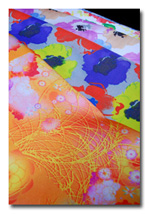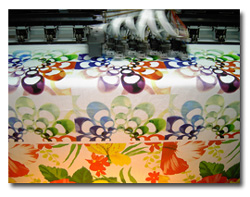O ne of the biggest challenges faced by designers and buyers in the textile industry today is the need to bring new designs to market at an ever increasing speed. Fashion has always been a fast-paced industry, but today top brands are incorporating new colors and styles onto their store floors at unprecedented speeds. Household and other textile applications are also beginning to experience similar pressure to provide more designs at a faster pace.
Fast-paced creativity has its costs. The creation of more styles and the desire to test an even greater pallet of colors require that additional sample and short run prints be produced for evaluation.
For years, sample and short run prints have been rather laboriously created using screen-jet printing. New screens are created for each sample and then discarded if the design is not approved. Today, many forward-thinking textile printers are creating enhanced efficiency by taking advantage of new digital textile inks to produce sample and short run prints faster and more cost-effectively.
The introduction of innovative, pigmented digital textile inks has revolutionized design, sampling and digital ink-jet printing over the past two years. Quality pigmented digital textile inks offer good color performance, as well as exceptional washfastness, lightfastness and fabric hand. After years of trial-and-error, digital textile printing has finally come of age offering short run printing that closely rivals screen-jet printing in terms of quality, but is light years ahead in terms of the ease and efficiency with which new designs and colors can be trialed.
This translates into opportunity for significant time and cost savings for textile printers. For example, sample production that would typically take a print house an average of two to three weeks to produce with screen-jet printing can now be turned around in as little as two to three days. This represents a 5-fold increase in production speeds and a major opportunity for designers and buyers who are anxious to get more new products to market faster and for the print houses who serve them. Additionally, because of the elimination of costs for new screens, average sample digital printing costs can be up to 90-percent less expensive than traditional screen-jet printing pricing.
To capitalize on these very significant time and cost savings and harness the revolution in digital textile printing to create a competitive advantage in this dynamic market, textile printers need to invest time in carefully identifying the right inks. As many print houses have learned the hard way, not all digital textile inks are created equally. Low quality inks can greatly slow production times and result in unacceptable print quality. To distinguish quality digital textile inks, users should carefully evaluate inks for compatibility, production performance and print quality.

Over the past two years, a new generation of digital textile inks have emerged that provide crisp, vibrant sample and short run printing in a wide color gamut that closely matches production print colors.
Compatibility
Range of Materials: To maximize efficiency, digital ink-jet ink should provide quality performance while being as versatile as possible. Inks should perform well and print efficiently on a variety of fabrics including cotton, cotton/polyester, nylon, rayon and silk.
Range of Printers: It also is important that the chosen ink be compatible with existing ink-jet equipment so as to avoid the need for expensive equipment modifications. Good inks should be compatible with any color textile digital printer with Epson piezo printheads, including Mimaki, Roland, Mutoh and Stork printers.
This compatibility with a wide range of existing textile printers makes it easy for both large and small print operations to inexpensively adopt and start production with quality digital textile inks.

The latest generation of digital textile inks are designed to provide
clog-resistant print on a variety of fabrics to minimize downtime
and maximize printing efficiency.
Production Performance
To maximize production speeds and minimize printing costs, look for inks with highly efficient production performance.
Reduced Printhead Clogging: Printhead clogging is one of the biggest causes of printing downtime and ink waste because valuable time is lost each time the printer must be shut down so the printhead can be cleaned. Recently, clog-resistant digital textile inks have been introduced which dramatically reduce this downtime and enhance printing efficiencies. For example, printhead cleaning is often needed two to four times per day when using traditional digital textile inks, but clog-resistant FabricFast from Trident can allow digital printers to go up to four days without the need for printhead maintenance, thereby minimizing costly downtime and reducing ink waste.
Environmentally Friendly Savings: Many consumers, designers, buyers and print houses have become more demanding in recent years in regards to identifying textile printing products that are more environmentally friendly. A new generation of economically friendly water-based inks has emerged to meet this need.
However, environmentally friendly digital ink-jet inks offer more than just more ecologically friendly materials. They also provide tangible bottom-line savings by reducing energy and product expenses during the printing process.
Screen printing process typically use dyes that require steaming for fixation followed by washing off the excess dye, followed by drying. This creates waste in terms of water, dye materials and energy consumption.
Unlike dye-based inks, pigmented water-based inks use a “dry” process and do not require post washing or the use of expensive steamers to bind inks to the fabric. The ink pigments are heat cured, eliminating the need for steaming and washing as required by other types of digital textile inks.
Print Quality
Accurate proofing can avoid expensive production mistakes by ensuring the desired color and appearance is achieved before screen printing begins. Make sure to evaluate digital textile inks on their ability to deliver color consistency and good fabric hand.
Color Consistency: Unfortunately, early digital textile inks were not able to match the true production colors used in large run screen prints, therefore making them less than ideal for sample printing. Fortunately, this situation has changed radically over the past two years. New ink-jet digital textile ink formulations match large-scale production pigment-based screen printing colors. The full market impact these inks are having is still being felt as manufacturers are discovering the advantages of having two processes that deliver equal color and quality.
Achieving accurate color does not require additional expense as pigment-based inks are comparably priced to dye-based inks. These pigmented digital textile inks come in a complete color gamut and can consistently match production color performance of screen jet printing.
Fabric Hand: There can be a marked difference in the fabric hand produced by pigmented versus dye-based inks and using screen-jet versus ink-jet printing technologies. Dye-based screen printing often provides better fabric hand than pigment-based screen printing. This happens because the engraved templates used for screen printing often apply excessive amounts of ink paste to fabrics resulting in stiff areas in the fabric where printing may chip or flake off as the material flexes.
The latest generation of pigmented digital inks provide better hand than pigmented screen-jet inks and nearly the same fabric hand as dye-based inks, but with improved lightfastness and less fading. Digital textile printing steadily regulates the amount of ink dispensed onto fabric, thereby creating enhanced fabric hand.
Digital textile printing’s consistently efficient ink disposal not only results in improved fabric hand, it also ensures less ink is wasted in the printing process, thereby generating additional cost savings.
The revolution in digital textile printing is set to play a key role in today’s dynamic market where print houses struggle to meet the ever growing needs of designers and buyers to have more new designs at a faster speed and lower price. Textile printers can achieve significant cost and time savings if they take the time to identify a quality water-based, pigmented digital textile ink.

 浙公網安33010602010414
浙公網安33010602010414